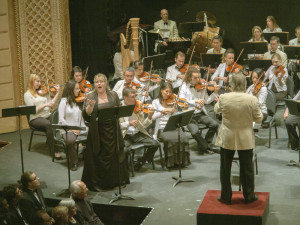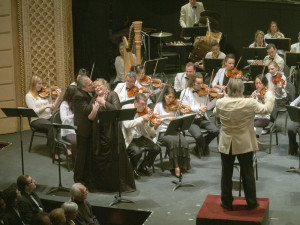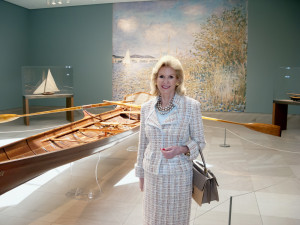 Andras Schiff performed J.S. Bach’s Six Partitas for Keyboard, BWV 825-830, Sunday, October 6, at San Francisco’s Davies Symphony Hall. “Awesome” was the comment of the Hedgehog’s co-editor, a man seldom given to exaggeration or the use of that word to describe a sandwich. It was an awe-inspiring event. For readers who were not there, I will try to describe this once in a lifetime experience and also urge upon you attendance at one of Mr. Schiff’s performances or, if that is not possible, a careful listen to one of his recordings. I had the privilege to hear Mr. Schiff on his earlier visit to San Francisco in which he both played and talked about Bach. While I wanted to write about what he said and did, I put it off; perhaps I imagined that some how my ordinary brain would wake up to a set of words to match the music. That did not happen. The Partitas are multi-movement suites. Each is different; one can not anticipate, “oh, there’s the Sarabande, here comes the Gigue.” Bach uses those dance forms ( yes, conservatory students, dance forms ) in wholly new ways of his limitless invention. He adds movements called “galanterien,” optional movements, that come from all sorts of forms: arias, capriccios, fantasias. Within each movement, there is more invention within and all around it. The rhythmic variety is dazzling. Both the right and left hand establish different, complex rhythms and then take off onto new ones. The result is beauty. It is beautiful in the way a sunset or a forest might be beautiful on one glance but more beautiful, a mysterious and challenging beauty, if one could look knowing that one was not seeing a static picture but myriad entities made up of countless atoms all in motion. It was a performance that required focus on the part of the audience. The focus and endurance of the artist is at a level combining the focus of a world champion chess player with a world champion Iron Man. Being a person who does neither chess nor Iron Man contests, I do not claim to know from the inside what that is like. I am reaching to understand. The performance of these technically wizardly compositions lasted about 2 hours and 45 minutes. I mention that lest someone think a solo performance would necessarily be brief. The first half included Partita No. 5, No. 3, No. 1, and No. 2. Each one contains delights. No. 5 has a Corrente movement which truly runs quick notes dashing through bright, happy harmonies. Its seventh and final movement is a thrilling Gigue which demands beyond virtuoso playing. The rhythmic inventions in No. 3 continually alter the listener’s perceptions and occasionally reveal just a glimpse of a dance. The stunning final movement, Capriccio, of No. 2 leaves the listener breathless. Partita No. 4 opened the first half offering part of an answer as to the artist’s choice of the order of the works. This Partita’s lyricism made it sound almost as though it were foretelling the musical future evolving into Romanticism. Bach’s genius transcends any classification by era or style, just as pure mathematics, another hobby this writer has yet to take up, knows no limits by year or geography. The Hedgehog co-editor told me after the concert that the Partitas are works that every serious piano student knows, or knows about, or has approached, although, he said, they are so very (extremely) difficult to play. Looking back, I realize how lucky I am that I was not familiar with these magnificent works. That is because when the final movement, a Gigue that took even the previous Gigues to another level of pure music and artistry, came suddenly to its end, the sudden gesture of both my hands to my mouth in amazement was entirely involuntary. Yes, 2 hours and 45 minutes without the many curtain calls and Mr. Schiff’s generous encore. I would have gladly stayed to hear it all again. Andras Schiff performs Bach’s Goldberg Variations and Beethoven’s Diabelli Variations, Sunday, Oct. 13, 7 p.m., Davies Symphony Hall, San Francisco.
Andras Schiff performed J.S. Bach’s Six Partitas for Keyboard, BWV 825-830, Sunday, October 6, at San Francisco’s Davies Symphony Hall. “Awesome” was the comment of the Hedgehog’s co-editor, a man seldom given to exaggeration or the use of that word to describe a sandwich. It was an awe-inspiring event. For readers who were not there, I will try to describe this once in a lifetime experience and also urge upon you attendance at one of Mr. Schiff’s performances or, if that is not possible, a careful listen to one of his recordings. I had the privilege to hear Mr. Schiff on his earlier visit to San Francisco in which he both played and talked about Bach. While I wanted to write about what he said and did, I put it off; perhaps I imagined that some how my ordinary brain would wake up to a set of words to match the music. That did not happen. The Partitas are multi-movement suites. Each is different; one can not anticipate, “oh, there’s the Sarabande, here comes the Gigue.” Bach uses those dance forms ( yes, conservatory students, dance forms ) in wholly new ways of his limitless invention. He adds movements called “galanterien,” optional movements, that come from all sorts of forms: arias, capriccios, fantasias. Within each movement, there is more invention within and all around it. The rhythmic variety is dazzling. Both the right and left hand establish different, complex rhythms and then take off onto new ones. The result is beauty. It is beautiful in the way a sunset or a forest might be beautiful on one glance but more beautiful, a mysterious and challenging beauty, if one could look knowing that one was not seeing a static picture but myriad entities made up of countless atoms all in motion. It was a performance that required focus on the part of the audience. The focus and endurance of the artist is at a level combining the focus of a world champion chess player with a world champion Iron Man. Being a person who does neither chess nor Iron Man contests, I do not claim to know from the inside what that is like. I am reaching to understand. The performance of these technically wizardly compositions lasted about 2 hours and 45 minutes. I mention that lest someone think a solo performance would necessarily be brief. The first half included Partita No. 5, No. 3, No. 1, and No. 2. Each one contains delights. No. 5 has a Corrente movement which truly runs quick notes dashing through bright, happy harmonies. Its seventh and final movement is a thrilling Gigue which demands beyond virtuoso playing. The rhythmic inventions in No. 3 continually alter the listener’s perceptions and occasionally reveal just a glimpse of a dance. The stunning final movement, Capriccio, of No. 2 leaves the listener breathless. Partita No. 4 opened the first half offering part of an answer as to the artist’s choice of the order of the works. This Partita’s lyricism made it sound almost as though it were foretelling the musical future evolving into Romanticism. Bach’s genius transcends any classification by era or style, just as pure mathematics, another hobby this writer has yet to take up, knows no limits by year or geography. The Hedgehog co-editor told me after the concert that the Partitas are works that every serious piano student knows, or knows about, or has approached, although, he said, they are so very (extremely) difficult to play. Looking back, I realize how lucky I am that I was not familiar with these magnificent works. That is because when the final movement, a Gigue that took even the previous Gigues to another level of pure music and artistry, came suddenly to its end, the sudden gesture of both my hands to my mouth in amazement was entirely involuntary. Yes, 2 hours and 45 minutes without the many curtain calls and Mr. Schiff’s generous encore. I would have gladly stayed to hear it all again. Andras Schiff performs Bach’s Goldberg Variations and Beethoven’s Diabelli Variations, Sunday, Oct. 13, 7 p.m., Davies Symphony Hall, San Francisco. 
Emerson String Quartet Welcomes Paul Watkins
 Music@Menlo, the premier chamber music festival, always provides stellar musicians, the finest in classical music, and innovative programming. Music lovers anywhere near Menlo Park-Atherton, CA, will have an opportunity on Sunday, October 13, to hear the renowned Emerson String Quartet perform with their new cellist, Paul Watkins. While he is new as a full time member of the Emersons, Mr. Watkins has played with individual members of the quartet in the last few seasons. He replaces cellist David Finckel in the first replacement of an Emerson member since 1979. Mr. Finckel is co-founder and co-artistic director of Music@Menlo with his wife, pianist Wu Han. The much honored couple together are also co-directors of the Chamber Music Society of Lincoln Center, New York, and Chamber Music Today, Seoul, Korea. No worries that Mr. Finckel will have too much leisure time on his hands. Mr. Watkins has been the cellist of the Nash Ensemble, in England, for 16 years. The Nash is a mixed chamber ensemble including piano and wind instruments with strings. He is also the Principal Conductor of the English Chamber Orchestra and a busy guest conductor and composer. When Mr. Watkins made his first appearance as a guest at Music@Menlo his extraordinary musicianship shone through delighting the Hedgehogs and the rest of the audience, too. Even as he was excellent as an ensemble member, he was clearly a special musician. The Emerson String Quartet has found an exciting new member. The 4 p.m., Oct. 13 concert is at the Center for Performing Arts at Menlo-Atherton. For tickets: see www.musicatmenlo.org or call 650/331-0202. The program includes quartets by Joseph Haydn, Shostakovich, and Mendelssohn. Future programs for M@M: Pianists in Paris with Jean-Efflam Bevouzet, Soyeon Kate Lee, Anne-Marie McDermott, Wu Han, Feb. 9; Alessio Bax, piano, May 11.
Music@Menlo, the premier chamber music festival, always provides stellar musicians, the finest in classical music, and innovative programming. Music lovers anywhere near Menlo Park-Atherton, CA, will have an opportunity on Sunday, October 13, to hear the renowned Emerson String Quartet perform with their new cellist, Paul Watkins. While he is new as a full time member of the Emersons, Mr. Watkins has played with individual members of the quartet in the last few seasons. He replaces cellist David Finckel in the first replacement of an Emerson member since 1979. Mr. Finckel is co-founder and co-artistic director of Music@Menlo with his wife, pianist Wu Han. The much honored couple together are also co-directors of the Chamber Music Society of Lincoln Center, New York, and Chamber Music Today, Seoul, Korea. No worries that Mr. Finckel will have too much leisure time on his hands. Mr. Watkins has been the cellist of the Nash Ensemble, in England, for 16 years. The Nash is a mixed chamber ensemble including piano and wind instruments with strings. He is also the Principal Conductor of the English Chamber Orchestra and a busy guest conductor and composer. When Mr. Watkins made his first appearance as a guest at Music@Menlo his extraordinary musicianship shone through delighting the Hedgehogs and the rest of the audience, too. Even as he was excellent as an ensemble member, he was clearly a special musician. The Emerson String Quartet has found an exciting new member. The 4 p.m., Oct. 13 concert is at the Center for Performing Arts at Menlo-Atherton. For tickets: see www.musicatmenlo.org or call 650/331-0202. The program includes quartets by Joseph Haydn, Shostakovich, and Mendelssohn. Future programs for M@M: Pianists in Paris with Jean-Efflam Bevouzet, Soyeon Kate Lee, Anne-Marie McDermott, Wu Han, Feb. 9; Alessio Bax, piano, May 11.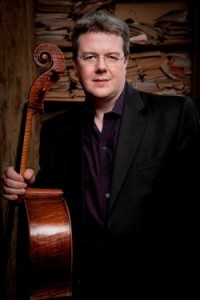
Weill Hall Meets Ruth Ann Swenson
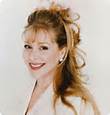 The exquisite opera star, Ruth Ann Swenson, cast her delightful spell through the exquisite Weill Hall of the Green Music Center at Sonoma State University, yesterday, Sept. 29. Ms Swenson is a unique operatic artist. Her angelic voice is matched by her ability to embody a complete character in a song. She is ardent, bereaved, playful, flirtatious, prayerful, and even funny. In each, she is completely convincing. As this writer overheard, the audience was moved and deeply impressed. A music lover from New York commented, “I’ve never seen or heard a great opera singer so able to become a different role. Such an amazing range of theater plus great music.” Charles Calhoun, San Francisco’s distinguished choral director, commented, “She is such an artist. I am amazed at her gift to become these different characters, project different emotions.” Ms Swenson was accompanied by pianist Warren Jones. Mr. Jones demonstrated not only his sensitivity to the singer, but also his own musicianship. He performed Three Pieces from Op. 118, by Brahms, and three mazurkas, thought to be the last music written by Chopin. In both, Mr. Jones’ playing was a bonus gift to the audience. Greatly skilled; he plays with understanding of the music. He becomes a perfect partner for the composer as he is for the singer. Ms Swenson’s program opened with Bellini’s Il fervido desiderio/The Fervent Wish. She immediately captivated everyone with this declaration of love. Her selections from Verdi let the audience know that they must be prepared to experience all of life in a few minutes. She sang Verdi’s La Seduzione/The Seduction, a story of cruelty and grief. Stornello/Refrain posed an opposite tale of love, “Constancy of love is foolish…I’m fickle and I flaunt it!” The program had beautiful surprises. This writer had never heard Ms Swenson sing Richard Strauss. Her three selections by this great composer for sopranos were magnificent. Allerseelen/All Souls’ Day, nostalgic and lovely, Breit’uber mein Haupt, full of sensuous longing “I want only the darkness of your raven locks, and the radiance of your gaze,” and Zueignung, a stirring declaration of dedication. The necessary brevity of an online posting prevents longer descriptions of the astonishing enactment of Mozart’s Quanti mi siete intorno… Padre, germani, addio from Idomeneo. “How many of you ruthless murderers surround me?” Or the refined, alluring L’heure exquise, by Reynaldo Hahn. Now it is time for a confession. This writer has long had an allergic response to opera divas singing American popular songs. Great big voices singing something that Hoagy Carmichael or Cole Porter wrote for something entirely different normally does not work. Not good for the song. Not good for the great big voice. It was a revelation to hear Ms Swenson sing On Such A Night As This, by Barer/Martin; They Say That Falling In Love/My Romance by Berlin/Rodgers&Hart; Embraceable You by G & I Gershwin. Each had been arranged for Ms Swenson by Richard Riccardi. Each was a jewel. Her pristine diction brought out the wit and insight of the lyrics. Her beautiful voice, matched perfectly to the arrangements, revealed the beauty of these musical treasures. She sang them as Ruth Ann Swenson singing great songs (not as an opera star pretending to be Billie Holliday). Good for the songs, good for the singer, S’Wonderful! for the audience. She gave more of herself in Somewhere Over The Rainbow, her encore. Ms Swenson will offer classes at Sonoma State. One must hope that the powers that be at the Weill Hall, Green Music Center, bring her back to perform again. And again. Her career began at the San Francisco Opera. For many years she sang at the Met, in New York, and at the great operas around the world. While she is near, let’s celebrate her magnificent gifts. Hear Ruth Ann Swenson and Warren Jones on the recording i carry your heart, EMI Classics.
The exquisite opera star, Ruth Ann Swenson, cast her delightful spell through the exquisite Weill Hall of the Green Music Center at Sonoma State University, yesterday, Sept. 29. Ms Swenson is a unique operatic artist. Her angelic voice is matched by her ability to embody a complete character in a song. She is ardent, bereaved, playful, flirtatious, prayerful, and even funny. In each, she is completely convincing. As this writer overheard, the audience was moved and deeply impressed. A music lover from New York commented, “I’ve never seen or heard a great opera singer so able to become a different role. Such an amazing range of theater plus great music.” Charles Calhoun, San Francisco’s distinguished choral director, commented, “She is such an artist. I am amazed at her gift to become these different characters, project different emotions.” Ms Swenson was accompanied by pianist Warren Jones. Mr. Jones demonstrated not only his sensitivity to the singer, but also his own musicianship. He performed Three Pieces from Op. 118, by Brahms, and three mazurkas, thought to be the last music written by Chopin. In both, Mr. Jones’ playing was a bonus gift to the audience. Greatly skilled; he plays with understanding of the music. He becomes a perfect partner for the composer as he is for the singer. Ms Swenson’s program opened with Bellini’s Il fervido desiderio/The Fervent Wish. She immediately captivated everyone with this declaration of love. Her selections from Verdi let the audience know that they must be prepared to experience all of life in a few minutes. She sang Verdi’s La Seduzione/The Seduction, a story of cruelty and grief. Stornello/Refrain posed an opposite tale of love, “Constancy of love is foolish…I’m fickle and I flaunt it!” The program had beautiful surprises. This writer had never heard Ms Swenson sing Richard Strauss. Her three selections by this great composer for sopranos were magnificent. Allerseelen/All Souls’ Day, nostalgic and lovely, Breit’uber mein Haupt, full of sensuous longing “I want only the darkness of your raven locks, and the radiance of your gaze,” and Zueignung, a stirring declaration of dedication. The necessary brevity of an online posting prevents longer descriptions of the astonishing enactment of Mozart’s Quanti mi siete intorno… Padre, germani, addio from Idomeneo. “How many of you ruthless murderers surround me?” Or the refined, alluring L’heure exquise, by Reynaldo Hahn. Now it is time for a confession. This writer has long had an allergic response to opera divas singing American popular songs. Great big voices singing something that Hoagy Carmichael or Cole Porter wrote for something entirely different normally does not work. Not good for the song. Not good for the great big voice. It was a revelation to hear Ms Swenson sing On Such A Night As This, by Barer/Martin; They Say That Falling In Love/My Romance by Berlin/Rodgers&Hart; Embraceable You by G & I Gershwin. Each had been arranged for Ms Swenson by Richard Riccardi. Each was a jewel. Her pristine diction brought out the wit and insight of the lyrics. Her beautiful voice, matched perfectly to the arrangements, revealed the beauty of these musical treasures. She sang them as Ruth Ann Swenson singing great songs (not as an opera star pretending to be Billie Holliday). Good for the songs, good for the singer, S’Wonderful! for the audience. She gave more of herself in Somewhere Over The Rainbow, her encore. Ms Swenson will offer classes at Sonoma State. One must hope that the powers that be at the Weill Hall, Green Music Center, bring her back to perform again. And again. Her career began at the San Francisco Opera. For many years she sang at the Met, in New York, and at the great operas around the world. While she is near, let’s celebrate her magnificent gifts. Hear Ruth Ann Swenson and Warren Jones on the recording i carry your heart, EMI Classics.
Yefim Bronfman, Tchaikovsky, the San Francisco Symphony
 Yefim Bronfman performed Tchaikovsky’s Piano Concerto No. 1 with the San Francisco Symphony, September 14, 2013. My eyes open wide and I shake my head; I am startled by my good luck to have been there. Please do not listen to anyone who belittles Tchaikovsky. There are those who will do it because too many others like his music. Do not listen to that noise, listen to Tchaikovsky. Mr. Bronfman played with power, grace, and understanding. He played delicately. He played so fast that I could not believe anyone’s fingers could move that way. He created a musical world. The SF Symphony met his need for a great partner in building this world. I want to say it was monumental; it was, but that word does not express the movement and life in the music. Mr. Bronfman played it into life. It is music that does not suggest a story but brought me to tears. The magnificence of his performance filled the hall with love, desperation, exaltation, with Tchaikovsky. The SF Symphony’s Music Director, Michael Tilson Thomas’s programming brilliance put Prokofiev’s Third Symphony on the same concert, after intermission and a chance to catch one’s breath. The SF Symphony played it as an overwhelming musical experience. The symphony, premiered in 1929, is full of struggle. All of the instruments are engaged in the battle. Knowing that the Symphony has sources in Prokofiev’s opera, The Fiery Angel, it could be the absolute struggle between good and evil, but it is a symphony, not an opera. The music has jagged, stabbing sounds and a quieter theme for the horns. There is no relief; the instruments assert their desires. It is a devilish battle. Search Prokofiev on the internet. Under his picture the caption is “Ballet Composer.” It is another harsh irony pursuing Prokofiev through the new century. Yes, ballets and Peter and the Wolf, but also the depths of this fantastic, cruel, reality in his Third Symphony. Thinking about Tchaikovsky and Prokofiev, a line from W.H.Auden’s poem, In Memory of W.B. Yeats, comes to mind. “Mad Ireland hurt you into poetry.” Both Tchaikovsky and Prokofiev were set upon by Russian struggles. Was Tchaikovsky too Western to be accepted as a great Russian composer? Were Prokofiev’s operas elements of pre-Revolutionary decadence? The bureaucrats with guns as well as other composers shouted, “Yes!” Auden asked the poet “with your unconstraining voice/Still persuade us to rejoice;” that is what Tchaikovsky and Prokofiev both could do and did for music and for us. Auden won’t claim “rejoice” because all is well, but because they could write this music.
Yefim Bronfman performed Tchaikovsky’s Piano Concerto No. 1 with the San Francisco Symphony, September 14, 2013. My eyes open wide and I shake my head; I am startled by my good luck to have been there. Please do not listen to anyone who belittles Tchaikovsky. There are those who will do it because too many others like his music. Do not listen to that noise, listen to Tchaikovsky. Mr. Bronfman played with power, grace, and understanding. He played delicately. He played so fast that I could not believe anyone’s fingers could move that way. He created a musical world. The SF Symphony met his need for a great partner in building this world. I want to say it was monumental; it was, but that word does not express the movement and life in the music. Mr. Bronfman played it into life. It is music that does not suggest a story but brought me to tears. The magnificence of his performance filled the hall with love, desperation, exaltation, with Tchaikovsky. The SF Symphony’s Music Director, Michael Tilson Thomas’s programming brilliance put Prokofiev’s Third Symphony on the same concert, after intermission and a chance to catch one’s breath. The SF Symphony played it as an overwhelming musical experience. The symphony, premiered in 1929, is full of struggle. All of the instruments are engaged in the battle. Knowing that the Symphony has sources in Prokofiev’s opera, The Fiery Angel, it could be the absolute struggle between good and evil, but it is a symphony, not an opera. The music has jagged, stabbing sounds and a quieter theme for the horns. There is no relief; the instruments assert their desires. It is a devilish battle. Search Prokofiev on the internet. Under his picture the caption is “Ballet Composer.” It is another harsh irony pursuing Prokofiev through the new century. Yes, ballets and Peter and the Wolf, but also the depths of this fantastic, cruel, reality in his Third Symphony. Thinking about Tchaikovsky and Prokofiev, a line from W.H.Auden’s poem, In Memory of W.B. Yeats, comes to mind. “Mad Ireland hurt you into poetry.” Both Tchaikovsky and Prokofiev were set upon by Russian struggles. Was Tchaikovsky too Western to be accepted as a great Russian composer? Were Prokofiev’s operas elements of pre-Revolutionary decadence? The bureaucrats with guns as well as other composers shouted, “Yes!” Auden asked the poet “with your unconstraining voice/Still persuade us to rejoice;” that is what Tchaikovsky and Prokofiev both could do and did for music and for us. Auden won’t claim “rejoice” because all is well, but because they could write this music.
Ruth Ann Swenson: Angel of Opera
Ruth Ann Swenson will perform at Weill Hall of the Green Music Center, Sonoma, CA, Sept. 29. You still have time to get a plane ticket or jump in your car if you are not near Sonoma. Do not miss this opportunity. One of the loveliest places on the planet, Sonoma is about to rejoice in one of the loveliest voices ever heard. Ms Swenson’s recital is part of a line up of major stars whose performances celebrate the opening of this new, acoustically perfect venue. (Itzhak Perlman will be there on the 21st; Herbie Hancock on the 28th.) It was a privilege to be in Ms Swenson’s audience when she sang the role of Desdemona, June 22, 2013, at the Astoria Music Festival. This writer has long considered Verdi’s Otello to be THE opera. The performance in Astoria’s legendary Liberty Theater lifted us all to a new level of experience. Ruth Ann Swenson sings like an angel must sing: pure pitch, always effortless whether the heights of her soprano or the depths, exquisite clarity when the notes come quickly. Praying alone in her bedchamber, her Desdemona broke our hearts with her music at the same time she led us to experience more understanding through the music alone. The Otello performance onstage in front of the orchestra was devised and conducted by Artistic Director Keith Clark. It was a masterful presentation, a proper way to recognize Verdi in his bicentennial year. In addition to Maestro Clark’s Festival Orchestra, Ms Swenson was joined by the powerful performances of Allan Glassman as Otello, and Richard Zeller as Iago. Together they created an Otello that still pierces my heart just remembering it. On Sept. 29, Ms Swenson will sing music by Bellini, Verdi, Mozart, Handel, Berlin/Rodgers & Hart, Gershwin, Lehar. For ticket information call 866/955-6040. The Green Center: 1801 E. Cotati Ave., Rohnert Park, CA. Photos: (L to R) Ruth Ann Swenson as Desdemona, Keith Clark conducting; Alan Glassman as Otello; June 22, 2013, Astoria Music Festival. Photos by Jonathan Clark.
Bach & Fleezanis@Music@Menlo
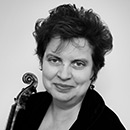 It is a joy to be in Jorja Fleezanis’ audience any time. On July 28, in her concert “Into the Light,” Ms Fleezanis, the rare artist who is loved as much as she is acclaimed, curated the program. She wrote that she chose music which “transports us from where we were before hearing a masterpiece to a place very different when it is over.” Music@Menlo’s 11th season, “From Bach,” presented an ideal theme for her selections. Each work, Ms Fleezanis wrote, “engages our many emotional temperatures.” She focused on music which lifts the listener into the light even while facing the darkest facts of human life. Bach’s Violin Concerto in E Major, dating from 1723, is not dated by the passage of centuries. In the wonderfully rhythmic first movement, Ms Fleezanis channeled Eleanor Powell, demonstrating through her playing and even the occasional foot tapping, the physical existence of music. It moves us as it moves the air waves. The dazzling rhythmic complexity provided a playground for the ensemble: Arnaud Sussman, Sean Lee, violins; Paul Neubauer, viola; Dmitri Atapine, ‘cello; Gloria Chien harpsichord. The dark reflection of the Adagio movement was not dismissed by the exuberant, lovely finale, but its presence made the energetic beginning and ending Allegros all the more precious. Mozart’s String Quintet no.4 in g minor (1787) recognizes pain and drama in the darkness, always present even if waiting off stage. Ms Fleezanis, Mr. Lee, violins; Mr. Neubauer, Sunmi Chang, violas; Laurence Lesser, ‘cello awakened the audience to the human answer to the dark: Here we are. We can play this music together. We can present Mozart’s thoughts to you 226 years after he met darkness with unique brilliance. Messiaen’s Theme and Variations for Violin and Piano (1932) was a surprise on the program of earlier music. It was played beautifully, enchanting anyone apprehensive about Messiaen’s technique. Ms Chien showed the piano’s percussive strength, and Ms Fleezanis’s violin took us on silken sails into the sky. It fit the artfully constructed program so well. Handel’s Eternal Source of Light Divine (1713), turned the program to sacred music. This work, also Ode to the Birthday of Queen Anne, cites the Queen as source of Light and Peace. The music gives thanks to God for “distinguished glory” adding “lustre to this day.” Performed by Elizabeth Futral, soprano; David Washburn, trumpet; Ms Fleezanis, Kristin Lee, violins; Ms Chang, viola; Mr. Atapine, ‘cello; Hyeyeon Park, harpsichord; Handel’s faith lifts his music toward a peaceful heaven. The program closed with Jauchzet Gott in allen Landen (Praise to God of all the Earth) written by Bach ca. 1730. Mr. Washburn’s trumpet was stellar. Light and dark coexist throughout. In the slow movement, the music is reflective, sad, but in his text Bach does not swerve from praising and thanking God, promising to live a “devout life.” Having opened with the exaltation of “Jauchzet!” “Joyfully praise!” the cantata returns to Alleluia. Ms Fleezanis, meeting Bach, offers joy.
It is a joy to be in Jorja Fleezanis’ audience any time. On July 28, in her concert “Into the Light,” Ms Fleezanis, the rare artist who is loved as much as she is acclaimed, curated the program. She wrote that she chose music which “transports us from where we were before hearing a masterpiece to a place very different when it is over.” Music@Menlo’s 11th season, “From Bach,” presented an ideal theme for her selections. Each work, Ms Fleezanis wrote, “engages our many emotional temperatures.” She focused on music which lifts the listener into the light even while facing the darkest facts of human life. Bach’s Violin Concerto in E Major, dating from 1723, is not dated by the passage of centuries. In the wonderfully rhythmic first movement, Ms Fleezanis channeled Eleanor Powell, demonstrating through her playing and even the occasional foot tapping, the physical existence of music. It moves us as it moves the air waves. The dazzling rhythmic complexity provided a playground for the ensemble: Arnaud Sussman, Sean Lee, violins; Paul Neubauer, viola; Dmitri Atapine, ‘cello; Gloria Chien harpsichord. The dark reflection of the Adagio movement was not dismissed by the exuberant, lovely finale, but its presence made the energetic beginning and ending Allegros all the more precious. Mozart’s String Quintet no.4 in g minor (1787) recognizes pain and drama in the darkness, always present even if waiting off stage. Ms Fleezanis, Mr. Lee, violins; Mr. Neubauer, Sunmi Chang, violas; Laurence Lesser, ‘cello awakened the audience to the human answer to the dark: Here we are. We can play this music together. We can present Mozart’s thoughts to you 226 years after he met darkness with unique brilliance. Messiaen’s Theme and Variations for Violin and Piano (1932) was a surprise on the program of earlier music. It was played beautifully, enchanting anyone apprehensive about Messiaen’s technique. Ms Chien showed the piano’s percussive strength, and Ms Fleezanis’s violin took us on silken sails into the sky. It fit the artfully constructed program so well. Handel’s Eternal Source of Light Divine (1713), turned the program to sacred music. This work, also Ode to the Birthday of Queen Anne, cites the Queen as source of Light and Peace. The music gives thanks to God for “distinguished glory” adding “lustre to this day.” Performed by Elizabeth Futral, soprano; David Washburn, trumpet; Ms Fleezanis, Kristin Lee, violins; Ms Chang, viola; Mr. Atapine, ‘cello; Hyeyeon Park, harpsichord; Handel’s faith lifts his music toward a peaceful heaven. The program closed with Jauchzet Gott in allen Landen (Praise to God of all the Earth) written by Bach ca. 1730. Mr. Washburn’s trumpet was stellar. Light and dark coexist throughout. In the slow movement, the music is reflective, sad, but in his text Bach does not swerve from praising and thanking God, promising to live a “devout life.” Having opened with the exaltation of “Jauchzet!” “Joyfully praise!” the cantata returns to Alleluia. Ms Fleezanis, meeting Bach, offers joy.
Impressionist Paintings/San Francisco
 Summer in San Francisco is a time to appreciate the beauty of light on the water at the SF Bay or the Pacific Ocean. The Legion of Honor Museum, perched above the Pacific in one of the few spots with a gorgeous view of both the Bay and Ocean at the same time, offers visitors a glorious exhibition, Impressionists on the Water. It opened June 1 and runs through October 13, 2013. More than 80 paintings and works on paper demonstrate the artists’ fascination with water, light, and color in works by Renoir, Monet, Pissarro, Caillebotte and post-Impressionists including Denis and Signac. When I had the opportunity to tour the exhibit with the distinguished guest curators, I mentioned to one of them, Christopher Lloyd, former Keeper of Queen Elizabeth’s collection, that I thought they had painted all those boats just because they were pretty. He said that he had once thought that, too. Instead, it turns out that they were all involved in boating, knowledgeable about yacht construction and sometimes active in competitions. In Regatta in Argenteuill, Gustav Caillebotte shows three different views of his sail boat and a self-portrait of himself steering with one finger. He was an expert boat designer and proud of his boats’ speed. The guest curators include Phillip Dennis Cate, former director of the Zimmerli Art Museum, Rutgers Univ., and the marine historian, Daniel Charles. To look at these paintings is to feel the refreshing movement of the water through the active brushstrokes. Photos: (above), Boats Moored at Le Petit-Gennevilliers (1874), Monet; (L-R)Regatta at Argenteuill (1893), Caillebotte; Sunflowers Along the Seine (1885-1886), Caillebotte; Oarsmen at Chatou (1879), Renoir(pictures courtesy of FAMSF). Mrs. Diane B. Wilsey, President, Board of Trustees, Fine Arts Museums of San Francisco (photo by Jonathan Clark). Mrs.Wilsey is standing by the boat, Nana, believed to have belonged to the author, Emile Zola.
Summer in San Francisco is a time to appreciate the beauty of light on the water at the SF Bay or the Pacific Ocean. The Legion of Honor Museum, perched above the Pacific in one of the few spots with a gorgeous view of both the Bay and Ocean at the same time, offers visitors a glorious exhibition, Impressionists on the Water. It opened June 1 and runs through October 13, 2013. More than 80 paintings and works on paper demonstrate the artists’ fascination with water, light, and color in works by Renoir, Monet, Pissarro, Caillebotte and post-Impressionists including Denis and Signac. When I had the opportunity to tour the exhibit with the distinguished guest curators, I mentioned to one of them, Christopher Lloyd, former Keeper of Queen Elizabeth’s collection, that I thought they had painted all those boats just because they were pretty. He said that he had once thought that, too. Instead, it turns out that they were all involved in boating, knowledgeable about yacht construction and sometimes active in competitions. In Regatta in Argenteuill, Gustav Caillebotte shows three different views of his sail boat and a self-portrait of himself steering with one finger. He was an expert boat designer and proud of his boats’ speed. The guest curators include Phillip Dennis Cate, former director of the Zimmerli Art Museum, Rutgers Univ., and the marine historian, Daniel Charles. To look at these paintings is to feel the refreshing movement of the water through the active brushstrokes. Photos: (above), Boats Moored at Le Petit-Gennevilliers (1874), Monet; (L-R)Regatta at Argenteuill (1893), Caillebotte; Sunflowers Along the Seine (1885-1886), Caillebotte; Oarsmen at Chatou (1879), Renoir(pictures courtesy of FAMSF). Mrs. Diane B. Wilsey, President, Board of Trustees, Fine Arts Museums of San Francisco (photo by Jonathan Clark). Mrs.Wilsey is standing by the boat, Nana, believed to have belonged to the author, Emile Zola.
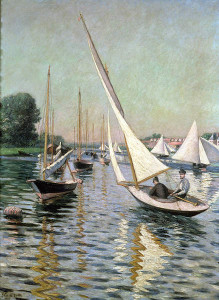
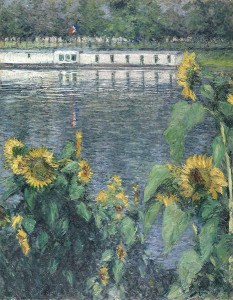
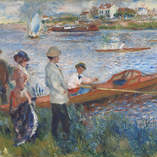
Dvorak & San Francisco Symphony
For the longest time, I thought that tune was an American folk song, like “Shenandoah,” or even “Sweet Betsy from Pike.” Not so. Instead, it is entirely original and at the heart of From the New World, Symphony No. 9 in E minor by Antonin Dvorak. There’s a lot of commentary about how he wrote it. He lived in New York in 1892. A determined visionary, Jeanette Thurber, wanted to create the National Conservatory of Music, a place where students of any gender, race/ethnicity, or economic background could study with the finest musicians. She really did make it happen and brought Dvorak to lead it. He and most of his family came from Bohemia, staying, with only one return to Europe, until 1895. He enjoyed the African-American music he heard, ragtime, and the nearly authentic Native American music he heard at Buffalo Bill Cody’s extravaganzas. And yet, Dvorak was not a researcher. So, how did this great-hearted symphony come to Dvorak? It is true that he said, “I am now satisfied that the future music of this country must be founded upon what are called the African American melodies,” but the symphony, written in 1893, is definitely his own and written as a European symphony. Dvorak is the de Tocqueville of great music. Just as that young Frenchman came to America and immediately understood what was going on here, Dvorak came to the US and wrote masterpieces which to our ears are our masterpieces expressing a truth about America better than anyone else. It was a truth about who we wish to think we are. On June 1, 2013, The San Francisco Symphony, conducted by Juraj Valcuha, performed it with all the energy, optimism and yearning that propels this great, humane work. Nostalgia for a place that may never have existed, except at the core of our values, entwines with musical invention and insights. Two years later, in 1895, Dvorak wrote Cello Concerto in B minor, Opus 104. The June 1, 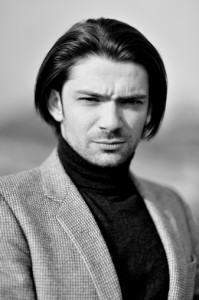
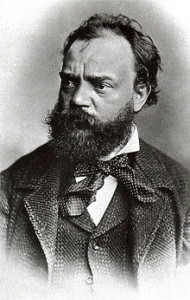
 soloist, Gautier Capucon, played the astonishing concerto with power and understanding. While it is the cello’s piece, the opening movement features a breathtaking horn solo. There is a virtuosic, dancing pace and the introduction of one of Dvorak’s songs which returns near the close. I am sometimes amused and amazed by critics’ commentaries on performances I have attended. One writer in order to praise Capucon mentioned that his playing managed to rise above this old warhorse of the classical repertory. Taking nothing away from Capucon’s masterful performance, one must remember he was performing this particular music, and it is earth shaking music. It opened a magical door to the cello. Allowing us to hear what poetry could come from that instrument, Dvorak pushed the symphonic world into a world of more and different sounds. Hearing it, Brahms said, “Why in the world didn’t I know one could write a cello concerto like this? If I’d only known I’d have done it long ago!” That’s good enough for me. Photos (L to R) G.Capucon, A.Dvorak, J.Valcuha.
soloist, Gautier Capucon, played the astonishing concerto with power and understanding. While it is the cello’s piece, the opening movement features a breathtaking horn solo. There is a virtuosic, dancing pace and the introduction of one of Dvorak’s songs which returns near the close. I am sometimes amused and amazed by critics’ commentaries on performances I have attended. One writer in order to praise Capucon mentioned that his playing managed to rise above this old warhorse of the classical repertory. Taking nothing away from Capucon’s masterful performance, one must remember he was performing this particular music, and it is earth shaking music. It opened a magical door to the cello. Allowing us to hear what poetry could come from that instrument, Dvorak pushed the symphonic world into a world of more and different sounds. Hearing it, Brahms said, “Why in the world didn’t I know one could write a cello concerto like this? If I’d only known I’d have done it long ago!” That’s good enough for me. Photos (L to R) G.Capucon, A.Dvorak, J.Valcuha.
Missa Solemnis:Beethoven & San Francisco Symphony
 If I had been given the chance to choose a Beethoven program to attend, it would not have been this one with Missa Solemnis as the big Beethoven event. It even had another Missa in the first half; this one by Palestrina. Lucky for me that Michael Tilson Thomas is a gifted programmer and also takes his musical educator role so seriously as he does. The concert by the San Francisco Symphony and the SF Symphony Chorus was beautiful, complex, inspiring. I wanted it all to happen again immediately.
If I had been given the chance to choose a Beethoven program to attend, it would not have been this one with Missa Solemnis as the big Beethoven event. It even had another Missa in the first half; this one by Palestrina. Lucky for me that Michael Tilson Thomas is a gifted programmer and also takes his musical educator role so seriously as he does. The concert by the San Francisco Symphony and the SF Symphony Chorus was beautiful, complex, inspiring. I wanted it all to happen again immediately.
The Palestrina work opened the program. In fact, it had the effect of opening the whole symphony building. By its conclusion, it seemed that the roof of the hall had lifted up and opened as the walls expanded infinitely. This is an all choral piece, no accompanying orchestra; the San Francisco Symphony Chorus performed so well that they seemed to disappear, leaving pure sound to occupy the ever expanding space. This was the first SF Symphony performance of Palestrina’s Missa Papae Marcelli (Pope Marcellus Mass) from the late 1550s or early 1560s. The audience, eyes open with surprise, floated to intermission. The word “balance” appeared frequently in the program notes, and balance is the answer to put into earthly terms the sense of perfect peace achieved by this work.
With Beethoven’s Missa Solemnis the SF Symphony, SF Symphony Chorus, soloists Laura Claycomb, soprano, Sasha Cooke, mezzo-soprano, Michael Fabiano, tenor, Shenyang, bass-baritone, Conductor Michael Tilson Thomas led the listeners into a different world. Here the energy, tumult, desperation, exaltation of every breath of life for all time engulfs the audience. As prayers of praise, for forgiveness, and sanctifying blessings pour forth, the voice of the music is sometimes the human lost, sometimes the human awed and humbled, even the human sensing glory.
In the Gloria (Glory be to God on high, and on earth/peace to men of good will.) the rhythm goes from walking steps to a levitation into air. In Sanctus (Holy, holy, holy) at the line Benedictus qui venit in nomine Domine (Blessed is he that comes in the name of the Lord) a single violin comes between soloists and chorus in a piercingly beautiful line that sounds like sweetness and truth if they had a sound.
This is the work that Beethoven devoted the most time to create. It has the richness of his understanding of life and complex devotion. It reminds me that music is a physical thing that changes the air it moves through and so might change the heart that hears it. 
 pictures:(L) SFS Beethoven Project logo (Rt)SFS Music Director Michael Tilson Thomas
pictures:(L) SFS Beethoven Project logo (Rt)SFS Music Director Michael Tilson Thomas
Gifts From the Gods: Legion of Honor, San Francisco
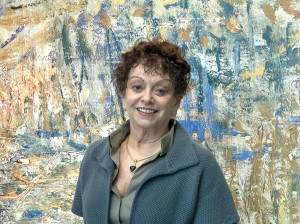
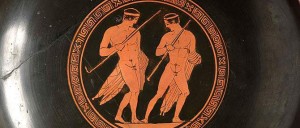 There is still time to view this fascinating exhibition at the Legion of Honor Museum, San Francisco. It closes June 23, 2013. The exhibition gathers art that grew from the Olympic ideal and from the Olympics themselves, both the ancient Olympics which happened every fourth year for 1000 years and the modern Olympics, revived in 1896. While you are there, remember to pick up the beautiful keepsake brochure that is offered (free!) on a rack in the gallery. It is illustrated with pictures of the rare, Greek coins, sculpture, golden laurel wreath and other art that tell the dramatic story. Written by curator Dr. Renee Dreyfus, it also offers amusing, historic, and inspiring commentary taken from ancient admirers of the athletes. The ancients started out with the religious belief that both art and athletics were gifts from the gods. Over time, the religious connection faded but admiration for the marvelous human body did not fade. Men in motion, yes, mostly men, motivated artists and philosophers to create tributes to specific athletes and particular sports. The coins show chariot races, foot races, wrestling, the discus. Fans of Olympic achievements will find so much to enjoy in this exhibition. They will also see how events changed over time. Wrestling in ancient times was done standing up. The winner was the one who threw his competitor to the ground three times. There were ancient competitions for women, commemorated in coins. They were not in the Olympic Games but in their own festival dedicated to the goddess Hera. The virgin competitors ran in separate categories according to their ages. Photos and posters of modern athletes and memorable Olympics such as the one in 1936 when Jesse Owens upset Hitler’s propaganda and 1972 when terrorists murdered Israeli athletes. Enthusiasm for the athletes is expressed by Lucian, 2nd century AD: “if you were seated among the spectators feasting your eyes on the prowess and stamina of the athletes, the beauty and power of their bodies, their incredible dexterity and skill, their invincible strength, their courage, ambition, endurance, and tenacity. You would never stop…applauding them.”Pictures:(Left)Curator Renee Dreyfus (Right) Red-figure kylix showing two athletes, Greek, Athens, 440-430 BC.
There is still time to view this fascinating exhibition at the Legion of Honor Museum, San Francisco. It closes June 23, 2013. The exhibition gathers art that grew from the Olympic ideal and from the Olympics themselves, both the ancient Olympics which happened every fourth year for 1000 years and the modern Olympics, revived in 1896. While you are there, remember to pick up the beautiful keepsake brochure that is offered (free!) on a rack in the gallery. It is illustrated with pictures of the rare, Greek coins, sculpture, golden laurel wreath and other art that tell the dramatic story. Written by curator Dr. Renee Dreyfus, it also offers amusing, historic, and inspiring commentary taken from ancient admirers of the athletes. The ancients started out with the religious belief that both art and athletics were gifts from the gods. Over time, the religious connection faded but admiration for the marvelous human body did not fade. Men in motion, yes, mostly men, motivated artists and philosophers to create tributes to specific athletes and particular sports. The coins show chariot races, foot races, wrestling, the discus. Fans of Olympic achievements will find so much to enjoy in this exhibition. They will also see how events changed over time. Wrestling in ancient times was done standing up. The winner was the one who threw his competitor to the ground three times. There were ancient competitions for women, commemorated in coins. They were not in the Olympic Games but in their own festival dedicated to the goddess Hera. The virgin competitors ran in separate categories according to their ages. Photos and posters of modern athletes and memorable Olympics such as the one in 1936 when Jesse Owens upset Hitler’s propaganda and 1972 when terrorists murdered Israeli athletes. Enthusiasm for the athletes is expressed by Lucian, 2nd century AD: “if you were seated among the spectators feasting your eyes on the prowess and stamina of the athletes, the beauty and power of their bodies, their incredible dexterity and skill, their invincible strength, their courage, ambition, endurance, and tenacity. You would never stop…applauding them.”Pictures:(Left)Curator Renee Dreyfus (Right) Red-figure kylix showing two athletes, Greek, Athens, 440-430 BC.
